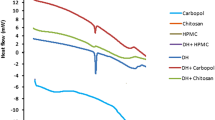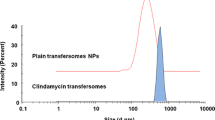Abstract
Triamcinolone acetonide (TA) is a corticosteroid that is used in the systemic and topical treatment of many inflammatory diseases. In this study, a phonophoretic drug delivery system was designed to enhanced the TA permeability and the influence of ultrasound was examined. In order to establish the transdermal delivery system for TA, a hydrophilic carbopol gel containing TA was prepared after adopting phonophoresis. A permeation study treatment was carried out for 10 h. The level of TA permation through the skin was evaluated under various ultrasound conditions including the frequency (1.0, 3.0 MHz), intensity (1.0, 2.5 W/cm2), and duty cycle (continuous, pulse mode) using a 0.5% TA gel. The highest permeation was observed under the ultrasound treatment conditions of low frequency, high intensity, and in continuous mode.
Similar content being viewed by others
References
Ahn, H. A., Transdermal delivery of cationic drug, isopropamide through rat skin by iontophoresis. Ph. D. Thesis, Seoul Natl. Univ., Korea (1991).
Amit, J. and Jaideep, R., Sonicated transdermal drug transport.J. Control. Release, 83, 13–22 (2002).
Brucks, R., Nanavaty, M., Jung, D., and Siegel, F., The effect of ultrasound on the in vitro penetration ibuprofen through human epidermis, Pharm. Res., 6, 679–701 (1989).
Byl, N. B., The use of ultrasound as an enhancer for transcutaneous drug delivery: phonophoresis.Phys. Ther., 75, 539–553 (1995).
Cullander, C. and Guy, R. H., Sites of iontophoretic current flow into the skin: identification and characterization with the vibrating probe electrode.J. Invest Dermatol., 97, 55–64 (1991).
Denet, A. R., Vanbever, R. and Preat, V., Skin electroporation for transdermal and topical delivery.Adv. Drug Deliv. Rev., 56, 659–674 (2004).
Franz, T. J., Tojo, K., Shah, K. R., Kydoneuis, A. F., In, and Kydoneuis, A. F. (ed.), Transdermal delivery. treatise of controlled drug delivery. Marcel Dekker, New York, pp. 341–421, (1992).
Hadgraft, J., Hadgraft, J. E., and Potts, R. O., The effects of thermodynamic activity on percutaneous absorption.J. Pharm. Pharmacol., 25, 122–214 (1993).
Kondo, S. and Sugimoto, I., Enhancement of transdermal delivery by superfluous thermodynamic potential. I. Thermodynamic analysis of nifedipine transport across the lipoidal barrier.J. Pharmacobio-Dyn., 10, 587–594 (1987).
Lavon, I. and Kost, J., Ultrasound and transdermal drug delivery,D. D. T., 9, 670–676 (2004).
Le, L., Kost, J., and Mitragotri, S., Combined effect of low-frequency ultrasound and iontophoresis: applications for transdermal heparin delivery.Pharm. Res., 17, 1151–1154 (2000).
McElnay, J. C., Matthews, M. P., Harland, R., and McCafferty, D. F., The effect of ultrasound on the percutaneous absorption of lignocaine.Br. J. Clin. Pharmacol., 20, 421–424 (1985).
Meidan, V. M., Walmsley, A. D., and Irwin, W. J., Phonophoresis-is it a reality?Int. J. Pharm., 118, 129–149 (1995).
Mitragotri, S., Ultrasound-mediated transdermal drug delivery. Ph.D. Thesis, Massachusetts Institute of Technology, U.S.A., (1996).
Mitragotri, S., Blankschtein, D., and Langer, R., Ultrasound-mediated transdermal protein delivery.Science, 269, 850–853 (1995).
Mitragotri, S., Blankschtein, D., and Langer, R., Transdermal drug delivery using low-frequency sonophoresis.Pharm. Res., 13, 411–420 (1996).
Pliquett, U. and Weaver, J. C., Electroporation of human skin: simultaneous measurement of changes in the transport of two fluorescent molecules and in the passive electrical properties.Bioelectroehemistry and Bioenergetics, 39, 1–12 (1996).
Riviere, J. E. and Heit, M. C., Electrically-assisted transdermal drug delivery.Pharm. Res., 14, 687–697 (1997).
Shin, S. C., Cho, C. W., and Oh, I. J., Enhanced efficacy by percutaneous absorption of piroxicam from the poloxamer gels in rats.Int. J. Pharm., 193, 213–218 (2000).
Shin, S. C. and Kim, J. Y., Enhanced permeation of triamcinolone acetonide through the buccal mucosa.Eur. J. Pharm. Biopharm., 50, 217–220 (2000).
Shin, S. C. and Lee, J. Y., Enhanced transdermal delivery of triprolidine from the ethylene-vinyl acetate matrix.Eur. J. Pharm. Biopharm., 54, 325–328 (2000).
Singh, S. and Singh, J., Transdermal delivery of drugs by phonophoresis.A review.Drug Des. Del., 5, 259–265 (1990).
Southwell, D. and Barry, B. W., Penetration enhancers for human skins; Mode of action of 2-pyrrolidine and dimethyl-formamide on partition and diffusion of model compounds, Water, n-alcohols and caffeine.J. Investig. Dermatol., 80, 507–514 (1983).
Tachibana, K., Transdermal delivery of insulin to alloxan-diabetc rabbits by ultrasound exposure.Pharm. Res., 9, 952–954 (1992).
Tezel, A., Sens, A., and Mitragotri, S., Investigation of the role of cavitation in low-frequency sonophoresis using acoustic spectroscopy.J. Pharm. Sci., 91, 444–453 (1998).
Tyle, P. and Agrawala, P., Drug delivery by phonophoresis.Pharm. Res., 6, 355–359 (1989).
Ueda, H., Ogihara, M., Sugibayashi, K., and Morimoto, Y., Change in the electrochemical properties of skin and the lipid packing in stratum corneum by ultrasonic irradiation.Int. J. Pharm., 137, 217–224 (1996).
Walmsley, A. D. and Squier, C. A., Role of ultrasonics in facilitating cutaneous drug penetration.Dent. Res., 70, 720 (1991).
Waranis, P. and Sloan, K. B., Effect of vehicle and prodrug properties and their interactions on the delivery of 6-mercaptopurine through skin: Bisacyloxymethyl-6-mercaptopurine prodrugs.J. Pharm. Sci., 76, 587–595 (1987).
Yong, C. S., Rhee, J. D., and Choi, H. G., Factors affecting percutaneous absorption.J. Skin Barrier Res., 73, 329–333 (2000).
Author information
Authors and Affiliations
Corresponding author
Rights and permissions
About this article
Cite this article
Yang, JH., Kim, DK., Yun, MY. et al. Transdermal delivery system of triamcinolone acetonide from a gel using phonophoresis. Arch Pharm Res 29, 412–417 (2006). https://doi.org/10.1007/BF02968592
Received:
Issue Date:
DOI: https://doi.org/10.1007/BF02968592




